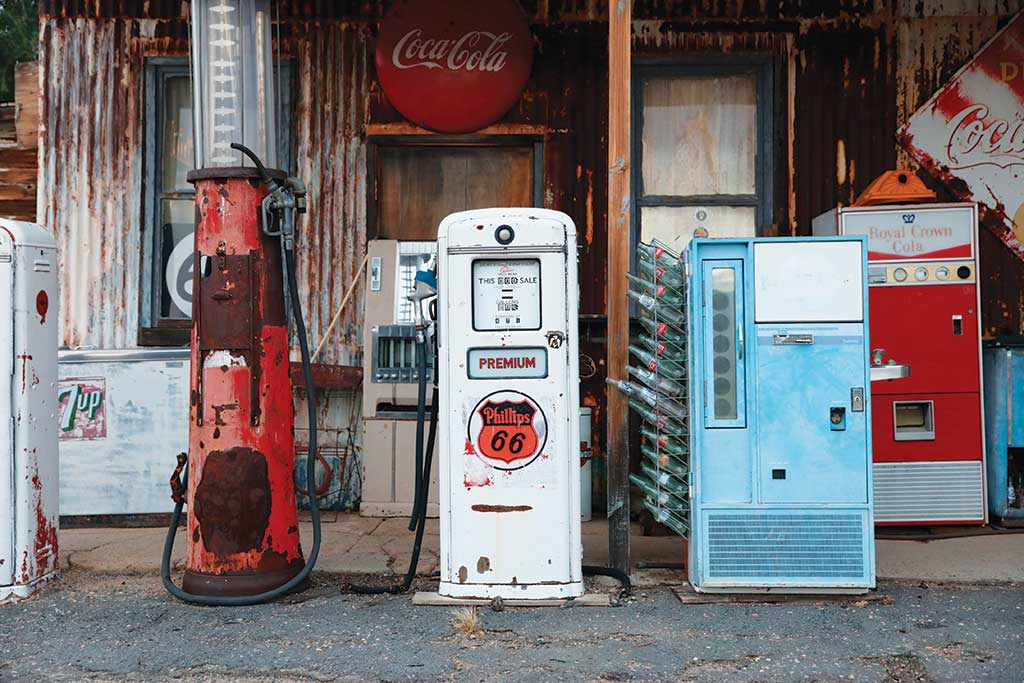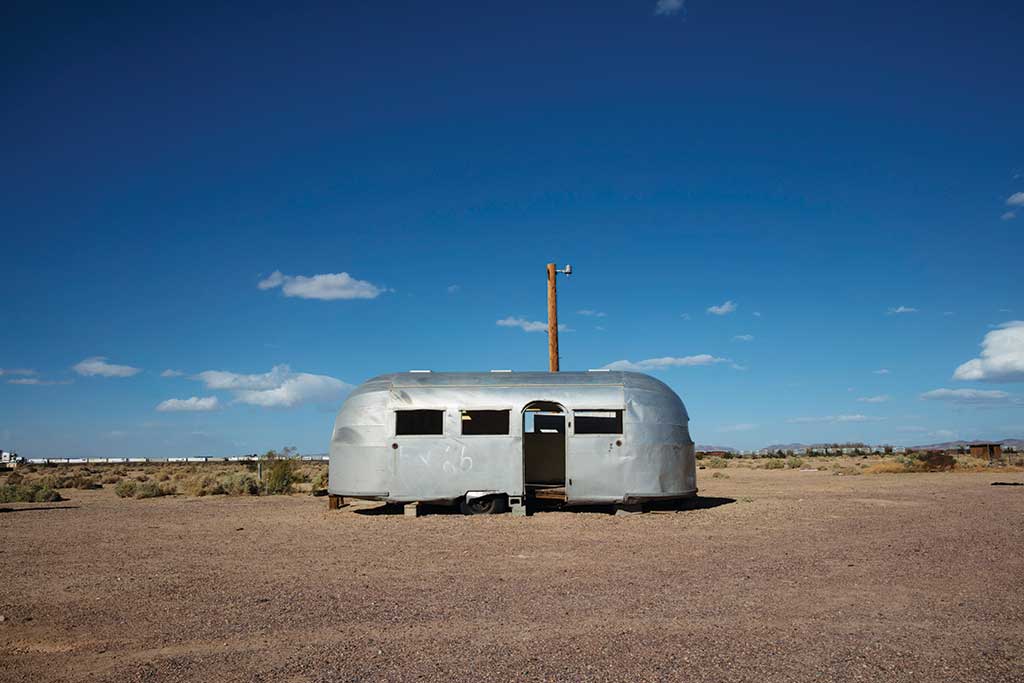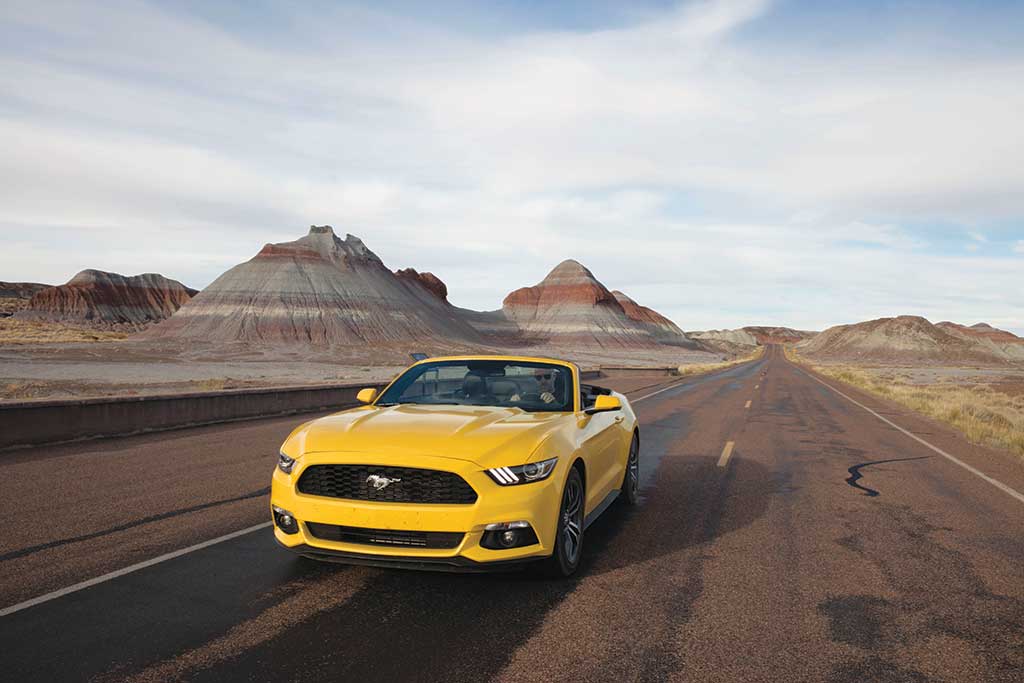The rotting bones of Route 66 are all over Missouri. That is to say that on the Show Me State portion of the road, which closely follows I-44, we see abandoned service stations, derelict motels, vintage signage, and so forth. We diligently photograph and admire them all and having said that, the state is full of quaint small towns like Cuba, Rolla, and Lebanon that all contain some legit Route 66 relics. Americana devotees will also want to slow down in Missouri cities like Springfield and Joplin whose main streets are filled with vintage bowling alleys, dive bars, and car washes that awkwardly rub shoulders with big box chains and fast food eateries.
Kansas proves an unlikely state for a trip highlight but it delivers just that. It’s surprising given that it lays claim to barely 13 miles of Route 66. Nevertheless, the town of Galena, the oldest mining town in southeast Kansas, hands us an unexpected moment of enchantment. We park Carol and stretch our legs at Cars on the Route, an old service station that has been restored and transformed into a souvenir shop. (The station’s larger claim to fame is that the rusty mining boom truck that sits out front inspired the character “Tow Mater” from the movie Cars.)

The Tower Conoco Station and U-Drop Inn in Shamrock, Texas
Because we arrive at dusk we are treated to a vainglorious sunset, which scorches the entire prairie leaving fiery hues of orange and pink all over the sky. Meanwhile, the town has come out in full tonight for a zombie pub crawl (it is nearly Halloween after all) and also a live music festival that draws hundreds to its town square. I now understand Dorothy’s yearning; if I could click my heels three times, I’d return to this moment in Kansas in a heartbeat.
The next day, we roll into Tulsa, Oklahoma at a late hour. It’s too dark for any kind of Route 66 discovery, but we love our one-bedroom suite at the Mayo Hotel, a Tulsa landmark that was built just before the stock market crash of 1929, abandoned in the 80s, and reopened more recently as a swanky downtown centerpiece. In its original incarnation it was a 66 stopping point for well-heeled travelers on the road and both façade and interior are gorgeous once again.
Gay nightlife in Tulsa, a city of nearly 400,000 people, is slim but there is the Tulsa Eagle, a magnet for just about any gay man in town over the age of 30 and tonight’s crowd is a smörgasbord of cowboys, hipsters, barflies, burnouts, and leather men. Although the dance floor is largely ignored, one guy in lederhosen is using it to do the chicken (his sartorial choice an apparent hat tip to Oktoberfest) alongside his much younger, strapping companion. This duo turns out to be Jerry, a late-life gay dad, and his young son Connor, a clean-cut fireman from Carthage, Missouri with a heart of gold and innocent world view. He tells us he has never left the prairie and his eyes widen like saucers when we explain our journey; he is visibly flattered by our tongue– cheek offer that he hit the road with us as we continue on to California.

Kingman, Arizona
We rise and shine in the Sooner State and pull back the curtains in our suite to discover our first gloriously sunny day on the road. We backtrack briefly to photograph and pay tribute to the Blue Whale of Catoosa, a waterfront attraction in suburban Tulsa that was built in the early 70s and has since become a recognizable Route 66 icon and a standard bearer of roadside kitsch.
Oklahoma is arguably the epicenter of Route 66 nostalgia including the Oklahoma Route 66 Museum in Clinton, the National Route 66 Museum in Elk City, and the Chandler Route 66 Interpretive Center. A state highlight for us includes lunch at POPS, an insanely popular retro diner and roadside attraction marked by a 66-foot and four ton soda bottle that is neon constructed but LED lit at night. The real draw, aside from the sculpture itself, are the more than 600 varieties of soda available by the bottle. I grimace at Ryan’s choice of bacon-flavored “pop” and instead settle on a simple Coke to wash down my burger and fries.
On April 19, 1995, the Alfred P. Murrah Federal Building in downtown Oklahoma City was bombed by domestic terrorists Timothy McVeigh and Terry Nichols. The blast destroyed or damaged more than 300 nearby buildings and claimed the lives of 168 people, and it’s at the contemplative Oklahoma City National Memorial and Museum, we experience our first moment of somber reflection. The memorial consists of a field of empty chairs, one for every life taken in the attack, a reflecting pool, survivors’ wall, survivor tree, and twin bronze gates.
Elsewhere in the capital there are two unmissable Route 66 land- marks including Buckminster Fuller’s knockout Gold Dome Building and around the corner from that the teensy Milk Bottle Grocery, a 350-square-foot triangular building with a large milk bottle on top. It’s worth noting here that much of Route 66 is smooth sailing, but trust me when I say you’ll be stopping every few minutes to admire the innumerable icons along the route—this is why it takes so long.
As we flee the capital and continue our journey westward, we more or less content ourselves with kicking up as much dust as possible along this desolate but peaceful stretch of Heartland where tumbleweeds, which we’ve previously only seen in cartoons, do in fact drift past us when we stop only to drop our pants and wiz along the side of the road. We stretch our legs in Texola, a border town with a population of 38 that perfectly illustrates the decline of the communities that once thrived along Route 66 but also provides us with a photo op at the Old Territorial Jail, a one-room jailhouse so small only a New Yorker could f ind envy in it.

The Airstream trailer Jack Palance slept in while filming Bagdad Cafe in Newberry Springs, California
Shamrock, Texas rewards us with our first Lone Star treasure in the form of a perfectly restored art deco Conoco Service Station, which we stand in front of and snap several requisite selfies. (The service station in nearby McLean is also a gem.) We stop for this only briefly as there are a bounty of prospects to claim before sundown, namely the Leaning Tower of Texas in Groom, a water tower that slants precariously to one side, the World’s Largest Cross, which is off the route but visible from it, and the VW Slugbug Ranch, an art installation consisting of a half dozen Volkswagen buggies half buried in the ground and spray painted in the kinds of vivid and garish neon colors that are all over Whitney Houston’s “How Will I Know” video from 1985.
Looking as loud, brash, and delightfully colorful as a drag queen dressed as a big-haired belle at a cotillion is the Big Texan Steak Ranch and Motel, a combination restaurant, gift shop, and motel (complete with swinging saloon doors in our bathroom!), and a veritable goldmine of roadside kitsch. Here is where you’ll find the kind of clientele for whom defending the Second Amendment is a way of life, but also where hospitality reigns supreme. At our banquet table, for example, is a big gal from Tennessee who kindly explains to us that the exasperated fellow perched atop the stage in the center of the dining room is attempting to devour a 72 oz. steak and all the victuals that come with it in one hour. If he succeeds, the meal is free. (He makes it less than halfway.) The world record, we’re told, is a 24-year-old woman and professional eater who did it in four minutes (the secret is to cut the meat into strips). When I brag to our server that I finished my chicken- fried steak and all it’s fixins’ in under an hour she brings me a child’s cowgirl hat as a reward, which I proudly wear intermittently throughout the trip.


